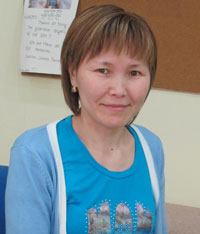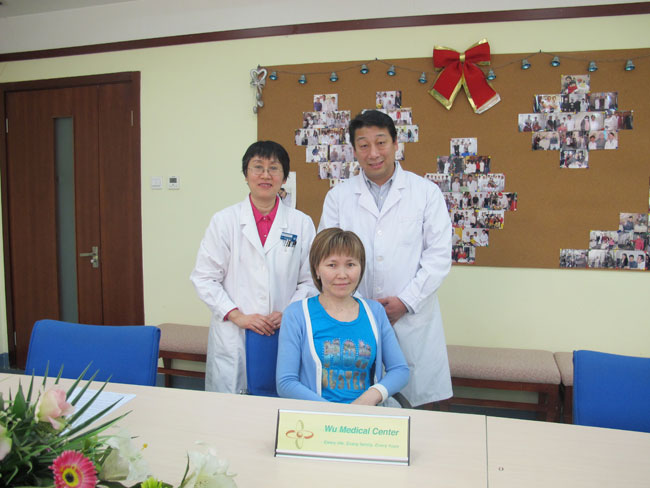Lena Mordvinova-Spinocerebellar ataxia (Russia) Posted on December 1, 2014
Name: Lena Mordvinova 
Sex: Female
Country:Russia
Age:39 years
Diagnosis: Spinocerebellar ataxia
Date: November 7, 2014
Days Admitted to Hospital: 21 days
Before treatment:
Two years ago, patient showed an abnormal and unbalanced walking gait. The condition became worse gradually. She had a genetic test on Nov 30, 2012 and was diagnosed as spinocerebellar ataxia, type I. She has tachycardia so she has been taking Metonponon to control the heart rate. In March 2013, she had closed craniocerebral injury due to falling; she had history of scalding and cosmetic injections. She had no other history of surgery. She was allergic to Amoxicillin.
Since the onset of the disease, the patient's spirit was good. Her diet and sleep were normal. Her urine and defecation were normal. The patient's mother, uncle, aunt and cousin had the same disease. There was no other hereditary disease.
Admission PE:
Bp: 104/68mmHg;; Hr: 89/min, temperature: 36.3 deg. Height: 164cm, weight:53Kg. Patient's figure was slightly lean. On the clavicle there was a scar of 8cm*2cm which resulted from scalding. The mucosa was intact, with no yellow stains or petechial or hemorrhagic spot. The pharyngeal had mild congestion and lymphoid follicle was seen on the wall of pharynx. Thorax was symmetrical and the breathing sounds in both lungs were clear, with no dry or moist rales. The heart sounds were strong, with no pathological murmur in auscultation area of each valve. The abdomen was sunken and soft. There were no masses under palpation. The liver and spleen were normal under palpation. The legs were not swollen.
Nervous System Examination:
Lena Mordvinova was alert. Her speech, memory, calculation and orientation were normal. Both pupils were equal in size and round, the diameter was 3.0mm. Both eyeballs could move freely and flexibly and the pupils were sensitive to light stimulus. There was no obvious nystagmus. The vision and visual field were normal. There were double visions if patient stared at her left and right sides. The wrinkles of her forehead were symmetrical. The tongue was centered in the oral cavity and the teeth were shown without deflection. She could raise the soft palate normally. The uvula was in the center of oral cavity. The hearing ability was normal. She could shrug shoulders and turn head with strong and symmetrical muscles normally. The muscle strength and muscle tone of her four limbs were normal. Bilateral biceps reflex, triceps reflex, radioperiosteal reflex and abdominal reflex were normal. Bilateral patellar tendon reflex and ankle reflex could not be elicited. Bilateral sucking reflex was negative. Left side Hoffmann sign was weak positive while right side was negative. The deep and shallow sensation of whole body was normal. She performed the finger-to-nose test with both sides in a slightly unstable manner. She could perform the rapid rotation test normally. She performed the heel- knee - tibia test in a slightly unstable way. The Romberg's sign was positive and she was not able to stand on one foot. She was presented with the typical walking gait of ataxia. She could not walk on a straight line and a pause could be observed when she turns around. She had a longer horizontal distance between two legs when she stood and walked. The meningeal irritation sign was negative.
Treatment:
We initially gave the patient a complete examination and she was diagnosed with spinocerebellar ataxia and infection of upper respiratory tract. She was given anti-infectious treatment. She also received treatment to initiate the restoration of nerves and regeneration of neural system. She received treatment to nourish her nerves, improve body circulation and improve immune system. This was accompanied by rehabilitation training.
Post-treatment:
The balance of Lena has improved. The index of Romberg's sign has greatly declined and the stability after closing her eyes has improved. She was able to stand on one foot. She can stand on left leg for 4 to 5 seconds and on her right foot for 5 to 7 seconds; the ability to walking on a straight line has improved and her walking gait is better. The symptom of double vision has improved.

